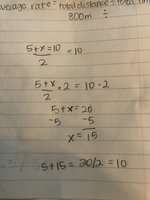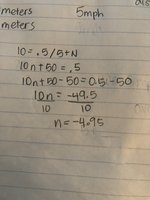If I run one lap around a track at a speed of 5 mph, how fast do I need to run the second lap so that my average pace over the two laps will be 10 mph?
This is a bonus (optional) question and I'd like to solve this but it does not pertain to any of the other objectives that I was taught so I'm not sure where to start.
Things I know because I've already looked it up-
This is a bonus (optional) question and I'd like to solve this but it does not pertain to any of the other objectives that I was taught so I'm not sure where to start.
Things I know because I've already looked it up-
- distance=rate*time
- average rate= total distance/total time
- 1 lap= 400 meters
Last edited:


